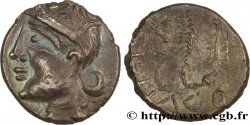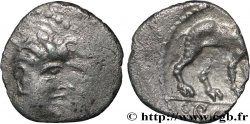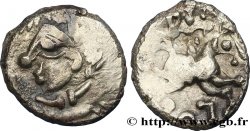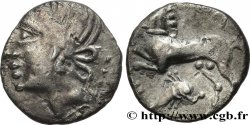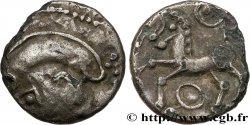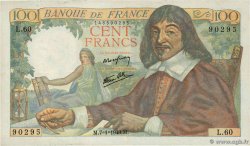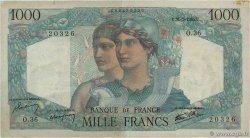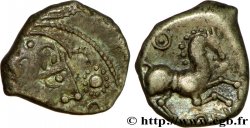v41_1557 - GALLIA - GALLIA DELLO SETTENTRIONALE - ÆDUI (BIBRACTE, Regione dello Mont-Beuvray) Denier ANORBOS/DVBNO, droit au globule perlé
MONNAIES 41 (2009)
Начальная цена : 320.00 €
Назначить цену : 500.00 €
Цена реализации : 351.00 €
Количество ставок : 2
Максимальная предлагаемая цена : 459.00 €
Начальная цена : 320.00 €
Назначить цену : 500.00 €
Цена реализации : 351.00 €
Количество ставок : 2
Максимальная предлагаемая цена : 459.00 €
Тип Denier ANORBOS/DVBNO, droit au globule perlé
Дата: c. 70-50 AC.
Монетный двор / Город: Autun (71)
Металл: silver
Диаметр: 13,5 mm
Ориентация осей монеты: 2 h.
Вес: 1,95 g.
Редкость: R3
Комментарии о состоянии
Flan un peu court et irrégulier, avec un portrait incomplet mais un beau visage. Revers complet et de frappe vigoureuse. Patine sombre et irisée, de collection ancienne
Ссылки в каталоге: :
Лицевая сторона
Аверс: легенда: ANÉPIGRAPHE.
Аверс: описание: Tête casquée à droite, le cou orné d’un torque ; deux globules entourés d’un annelet perlé et une esse, devant le visage.
Обратная сторона
Реверс: легенда: [DVBNO].
Реверс: Описание: Cheval bridé et sanglé galopant à droite, un annelet pointé au-dessus de la croupe ; grènetis.
Комментарий
Pour ce denier, il existe au moins deux types différents, avec ou sans l'annelet entre les jambes du cheval.
Cet exemplaire présente une variété originale de droit ; la légende ANORBO est terminée par un globule entouré d'un annelet perlé devant le nez. Cette caractéristique manque à tous les exemplaires connus et publiés, que ce soit dans les catalogues des principaux musées ou dans le récent Nouvel Atlas.
La légende étant hors flan sur cet exemplaire, il est permis de se demander s'il ne pourrait pas s'agir d'un monnayage anépigraphe au type de droit et de revers du denier LT. 4972, mais avec cet élément décoratif distinctif au droit ?
Nous avons déjà proposé un exemplaire avec cette variante ; le n° 801 de MONNAIES 31.
Cet exemplaire, du même type que le précédent, présente une double empreinte au droit, vestige d’un coin à empreintes multiples. Celles-ci sont particulièrement bien attestées pour ces deniers ANORBOS/DVBNO.
Cet exemplaire présente une variété originale de droit ; la légende ANORBO est terminée par un globule entouré d'un annelet perlé devant le nez. Cette caractéristique manque à tous les exemplaires connus et publiés, que ce soit dans les catalogues des principaux musées ou dans le récent Nouvel Atlas.
La légende étant hors flan sur cet exemplaire, il est permis de se demander s'il ne pourrait pas s'agir d'un monnayage anépigraphe au type de droit et de revers du denier LT. 4972, mais avec cet élément décoratif distinctif au droit ?
Nous avons déjà proposé un exemplaire avec cette variante ; le n° 801 de MONNAIES 31.
Cet exemplaire, du même type que le précédent, présente une double empreinte au droit, vestige d’un coin à empreintes multiples. Celles-ci sont particulièrement bien attestées pour ces deniers ANORBOS/DVBNO.








 Cообщить об ошибке
Cообщить об ошибке Распечатать страницу
Распечатать страницу Отправить мой выбор
Отправить мой выбор Задать вопрос
Задать вопрос Consign / sell
Consign / sell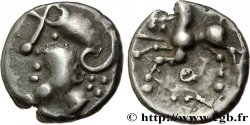
 Информация
Информация